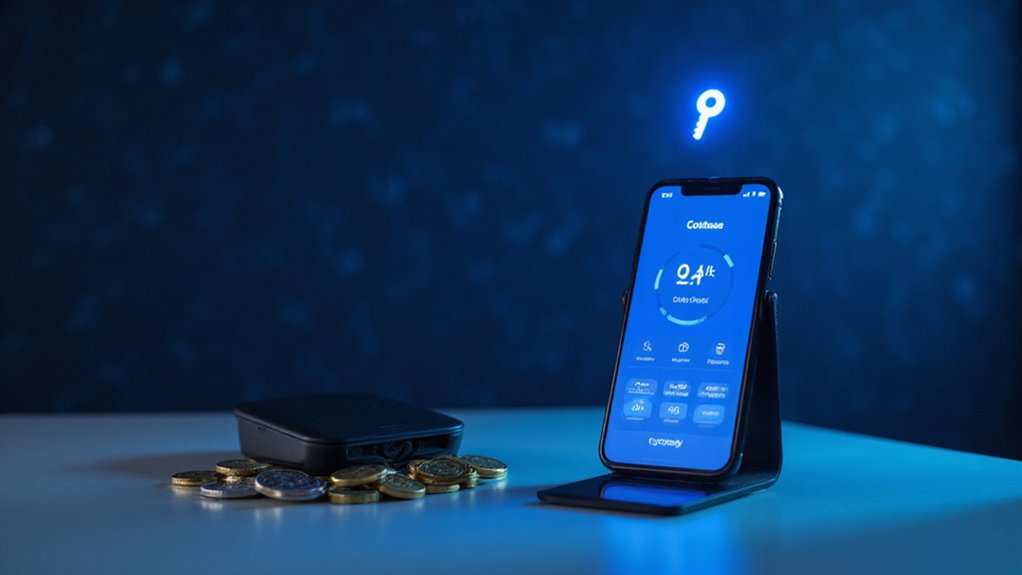A Web3 wallet functions as your digital passport to the decentralized internet—storing private keys that authenticate blockchain transactions while enabling interaction with decentralized applications. Unlike traditional financial services, these non-custodial tools grant users complete sovereignty over their digital assets across multiple networks (Ethereum, Solana, et al.) without intermediaries. Available as hardware devices, browser extensions, or mobile apps, they represent financial autonomy‘s double-edged sword: unprecedented control paired with sobering responsibility. The uninitiated might find this trade-off surprisingly consequential.

A Web3 wallet represents the digital skeleton key to the emerging decentralized internet, functioning as both repository and gateway for the blockchain-savvy user.
Unlike traditional wallets that bulge with credit cards and cash, these technological counterparts store something far more valuable in the digital domain: private keys that grant access to one’s blockchain assets.
Private keys—not leather billfolds—hold the true currency of our digital sovereignty in the blockchain age.
They serve as the fundamental interface through which individuals interact with decentralized applications (dApps), smart contracts, and the broader Web3 ecosystem—all without surrendering control to intermediaries.
The architecture of these wallets reflects the philosophical underpinnings of the decentralization movement itself.
Most Web3 wallets operate on a non-custodial basis, meaning users retain complete sovereignty over their assets rather than ceding control to third parties (a welcome departure from the standard financial paradigm, wherein banks effectively hold one’s wealth hostage).
They support multiple blockchains simultaneously, enabling users to manage diverse portfolios spanning Ethereum, Solana, Polygon, and beyond.
These digital instruments come in various configurations, each with distinct security profiles.
Hardware wallets—physical devices that store keys offline—offer fortress-like protection but sacrifice convenience.
Browser extensions and mobile applications provide accessibility at the potential cost of heightened vulnerability.
Smart contract wallets introduce sophisticated features like multi-signature requirements, ideal for organizational treasury management.
The operational mechanics remain elegantly straightforward: each wallet generates a public address for receiving assets and safeguards private keys for authorizing transactions.
Popular options like MetaMask support interactions with dApps on EVM-compatible blockchains for seamless integration with the decentralized ecosystem.
Solutions like MetaMask have gained millions of users by offering a user-friendly interface that balances security with convenience in managing cryptocurrency assets.
Recovery seed phrases—those carefully guarded strings of seemingly random words—serve as the ultimate failsafe should disaster strike.
Users must create secure backups of these seed phrases to enable restoration of their wallets and recovery of digital assets in case of device loss or failure.
With this power comes profound responsibility.
Users who misplace private keys or seed phrases face an unforgiving reality: permanent asset loss.
No customer service department exists to reset forgotten passwords in this trustless environment.
The decentralized web demands vigilance against phishing attempts, malware, and social engineering tactics—a small price, perhaps, for true financial autonomy in an increasingly centralized world.
Frequently Asked Questions
Are Web3 Wallets Safe From Hacking?
Web3 wallets remain susceptible to various attack vectors despite security advancements.
The ecosystem faces persistent threats from DNS hijacking, frontend injections, and sophisticated phishing campaigns—not to mention the ever-present specter of smart contract vulnerabilities.
While multi-signature implementations and hardware solutions offer enhanced protection, the $200M Mixin Network and $126M Poloniex breaches underscore an uncomfortable truth: absolute security remains elusive in the cryptographic frontier.
Can I Recover Lost Passwords or Seed Phrases?
Recovery of lost passwords or seed phrases depends entirely on wallet type.
Custodial wallets may offer identity verification options, while non-custodial wallets generally leave users stranded without their seed phrase (that 12-24 word lifeline many treat with surprising nonchalance).
Professional recovery services exist but come with hefty fees and no guarantees.
Advanced solutions like guardian-based recovery or Shamir’s Secret Sharing provide alternatives, though these require proactive implementation.
How Do Web3 Wallets Make Money?
Web3 wallets generate revenue through multiple streams: transaction fees on user activities, commissions from NFT marketplace integrations, revenue-sharing from DeFi protocol integrations, and staking services.
They also monetize through strategic partnerships and affiliate marketing with blockchain projects.
The genius of their business model lies in capturing value at each intersection of user activity—whether swapping tokens or farming yields—while maintaining the façade of decentralization that users so earnestly desire.
Which Web3 Wallet Has the Lowest Transaction Fees?
Among current Web3 wallets, Trust Wallet emerges as the fee minimizer, supporting 100+ blockchains without adding proprietary charges beyond unavoidable network fees.
Argent offers competitive pricing through ZKsync integration, while MetaMask—though ubiquitous—remains primarily Ethereum-bound (and subject to its notorious gas gymnastics).
The wallet landscape becomes a delicate balance: broader blockchain support typically translates to more opportunities for fee arbitrage across networks.
Can Web3 Wallets Work With Traditional Banking Systems?
Web3 wallets can interface with traditional banking systems, albeit through intermediary solutions that bridge the decentralized-centralized divide.
These integration points—ranging from fiat on-ramps to specialized APIs—must navigate regulatory hurdles (KYC/AML requirements) and technical incompatibilities between blockchain’s transparent ledgers and banks’ legacy infrastructure.
Emerging hybrid models and fintech partnerships are gradually surmounting these obstacles, though the marriage remains somewhat awkward—like forcing quantum physics to accommodate Newtonian mechanics.









